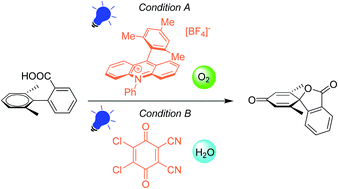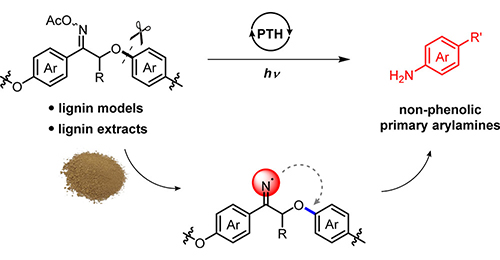

Tingting Hou, Nengchao Luo, Yi-Tao Cui, Jianmin Lu, Lei Li, Katherine E MacArthur, Marc Heggen, Ruotian Chen, Fengtao Fan, Wenming Tian, Shengye Jin, Feng Wang*
Appl. Catal. B-Environ., 2019, 245, 262-270
Engineering the electronic properties of heterogeneous catalysts is an important strategy to enhance their activity towards CO2 reduction. Herein, we prepared partially sulfurized cerium oxide (CeOx-S) nanoclusterswith the size less than 2 nm on the surface of ZnIn2S4 layers. Surface electronic properties of CeOx-S nanoclusters are facilely modulated by cerium coordination to sulfur, inducing ...

Hongji Li‡, Elena Subbotina‡, Anon Bunrit, Feng Wang*, Joseph S. M. Samec*
Chem. Sci., 2019, 10, 3681-3686
The idea of using biaryl structures to generate synthetic building blocks such as spirolactones is attractive because biaryl structures are abundant in biomass waste streams. However, the inertness of aromatic rings of biaryls makes it challenging to transform them into functionalized structures. In this work, we developed photoinduced dearomatization of nonphenolic biaryl compounds to generate...
Jianyu Han, Jianmin Lu, Min Wang, Yehong Wang, Feng Wang*
Chin. J. Chem., 2019, 37(9), 977-988
There have been remarkable progresses in manipulating heterogeneous catalysts' nanostructures in the past decade. The concept of single atom alloy (SAA) was firstly proposed in 2012 when researchers successfully stabilized single Pd atoms on the Cu(111) surface. However, earlier work in 2009, which focused on replacing one Au atom with a Pd atom in thiolate protected Au25 nanoclusters, cou...
Min Wang, Feng Wang*
Adv. Mater., 2019, 1901866
Lignin is an aromatic polymer, which is the biggest and most sustainable reservoir for aromatics. The selective conversion of lignin polymers into aryl monomers is a promising route to provide aromatics, but it is also a challenging task. Compared to cellulose, lignin remains the most poorly utilized biopolymer due to its complex structure. Although harsh conditions can degrade lignin, the...
Kimberly N. Heck, Yehong Wang, Gang Wu, Feng Wang, Ah-Lim Tsai, David T. Adamsond, Michael S. Wong*
RSC Adv., 2019, 9, 27042-27049
1,4-dioxane, commonly used as a solvent stabilizer and industrial solvent, is an environmental contaminant and probable carcinogen. In this study, we explored the concept of using metal oxides to activate H2O2 catalytically at neutral pH in the dark for 1,4-dioxane degradation. Based on batch kinetics measurements, materials that displayed the most suitable characteristics (high 1,4-dioxane d...
Jian Zhang, Yehong Wang, FengWang*
Inorg. Chem. Commun., 2019, 109, 107566
Here, we report the synthesis of an infinite coordination polymer (ICP) with 2,5-furan dicarboxylic acid (FDCA) and nickel acetate as precursors in a flow tubular microreactor in a continuous mode. Compared with the available synthesis methods, which usually span hours to days at elevated temperature, this strategy remarkably saves time and energy, and greatly increases the efficiency of s...

Hongji Li, Anon Bunrit, Jianmin Lu, Zhuyan Gao, Nengchao Luo, Huifang Liu, Feng Wang*
ACS Catal., 2019, 9, 8843-8851
Depolymerization of lignin meets the difficulty in cleaving the robust aryl ether bond. Herein, through installing an internal nucleophile in the β-O-4′ linkage, the selective cleavage of aryl ether was realized by the intramolecular substitution on aryl rings affording non-phenolic arylamine products. In particular, nitrogen-modified lignin models and lignin samples were employed to generate the iminyl radical under photocatalytic reduction, which acted as the internal nucleophile inducing aryl migration from O to the N atom. The following hydrolysis released primary arylamines and α-hydroxy ketones. Mechanism studies including electron spin resonance (ESR), fluorescence quenching experiments, and density functional theory (DFT) calculations proved the aryl migration pathway. This method enables access to non-phenolic arylamine products from lignin conversion.

Nengchao Luo, Tiziano Montini, Jian Zhang, Paolo Fornasiero, Emiliano Fonda, Tingting Hou, Wei Nie, Jianmin Lu, Junxue Liu, Marc Heggen, Long Lin, Changtong Ma, Min Wang, Fengtao Fan, Shengye Jin & Feng Wang*
Nat. Energy, 2019, 4(7), 575-584
We demonstrate the coproduction of H2 and diesel fuel precursors from lignocellulose-derived methylfurans via acceptorless dehydrogenative C−C coupling, using a Ru-doped ZnIn2S4 catalyst and driven by visible light. With this chemistry, up to 1.04 g /g catalyst/h of diesel fuel precursors (~41% of which are precursors of branched-chain alkanes) are produced with selectivity higher than 96%, together with 6.0 mmol/ g catalyst/ h of H2. Subsequent hydrodeoxygenation reactions yield the desired diesel fuels comprising straight- and branched-chain alkanes. We suggest that Ru dopants, substituted in the position of indium ions in the ZnIn2S4 matrix, improve charge separation efficiency, thereby accelerating C−H activation for the coproduction of H2 and diesel fuel precursors.